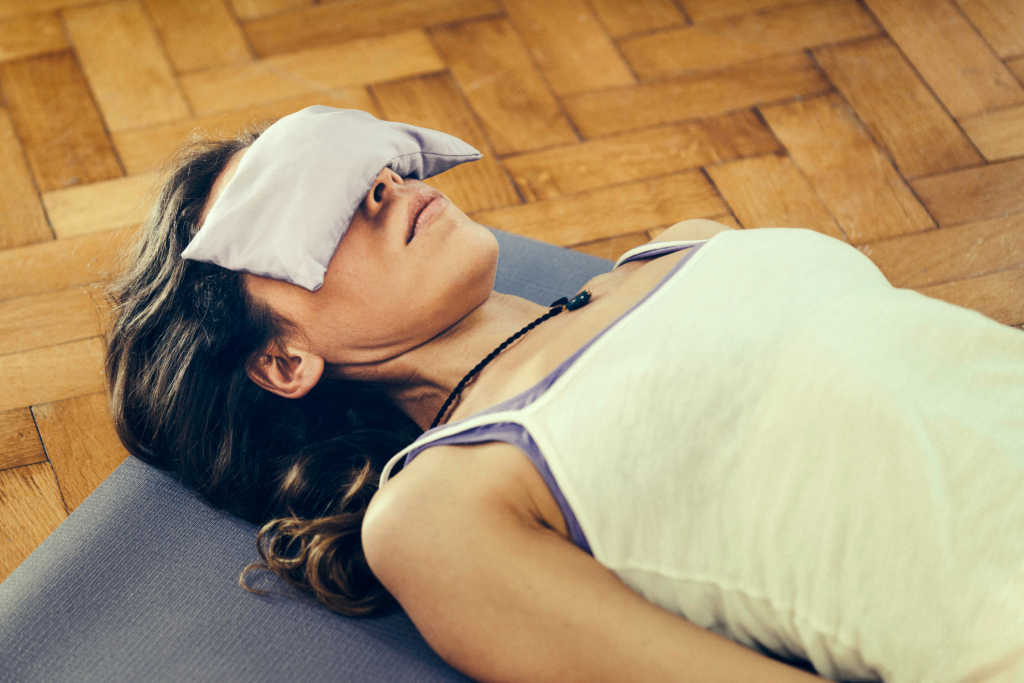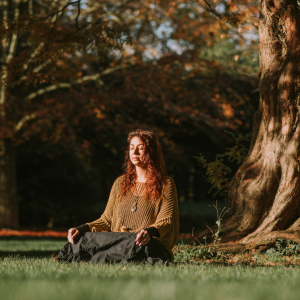Perhaps like most people I speak to, you’ve never heard of Yoga Nidra.
When you think of yoga, I’m guessing you think of the physical practise – moving through postures and focusing on your breath.
This is correct, and is a branch of yoga known as Yoga Āsana if you didn’t already know.
Other forms of yoga include Pranayama, Meditation, and yep, you guessed it.. Yoga Nidra.
You might be here because Yoga Āsana just isn’t your jam but you still feel a pull towards yoga, or maybe you want to deepen your practice in a different way or you’re just curious about Yoga Nidra.
Whatever the reason, just know that Yoga Nidra is a truly gentle yet profound practise that can open up the depth and wisdom of yoga and interconnectedness as much as any other practise.
So before we get into what Yoga Nidra is and it’s benefits, I just want you to know that I believe it’s such a beautiful blessing that your curiosity has lead you towards this deeply nourishing practise. It’s had such a profound impact on my life, and so my heart smiles knowing it’s gifts are entering into yours.
What is Yoga Nidra
Dating all the way back to the 6th and 7th centuries, it’s believed by some that Yoga Nidra was the original practice of meditation – or at least the original position it was practiced.
For this nourishing practice, you lay on your back in Shavasana and journey as awareness through the different layers of your being. You’re guided towards entering a state of pure consciousness; which is what’s known as Yoga Nidra / the fourth state of consciousness.
Western science and psychology show the mind to have 3 states of consciousness; waking state, dreaming state and deep sleep state. However, eastern philosophy recognises more than this, including Yoga Nidra or Turiya known as the fourth state in yogic philosophy.
Throughout the practice of Yoga Nidra, the practitioner moves through many states including Prajna, which is deep sleep experienced consciously.
The structure of the practice depends on the length of the class and whether there is a specific focus such as Yoga Nidra for reducing anxiety and stress or for better sleep; below is what you can expect from a full traditional session.
- Intro (getting comfy)
- Setting a sankalpa
- Anamaya kosha (the physical body/layer)
- Pranamaya kosha (the energetic body/layer)
- Manomaya kosha (the emotions and feelings body/layer)
- Vijnanamaya kosha (the intellectual body/layer)
- Anandamaya kosha (the bliss body/layer)
- Outro (coming back into the body)
Atma Vichara (self-enquiry) is also included in a full session of mine as taught by my teachers at Anuttara Ashram.
Benefits of Yoga Nidra
1. Reduces Stress & Anxiety
When stimulation levels and constant quick fixes are high in our lives, our sympathetic nervous system gets super busy. If it remains here in overdrive, it can release stress hormones by making the body decide between fighting or flying.
These stress hormones then send activity to the brain and into the bloodstream, which can accelerate things like anxiety, depression and high blood pressure.
When practising Yoga Nidra, you head towards the alpha state where serotonin is released. This is often known as the body’s natural ‘feel good’ chemical, which when at normal levels helps you to feel happier, calmer and emotionally balanced.
By entering this state in Yoga Nidra, the mind slows down massively, which creates serious physical relaxation, calmness in the mind and restful emotions.
When your body, breath, emotions and mind are this relaxed, your entire being is released enough to be lead into the tranquil stillness far away from stress and anxiety.
2. Erase Destructive Thought Patterns and Habits
As you travel deeper through Yoga Nidra, brainwaves are produced that imitate deep sleep.
So the difference between actual deep sleep and the state experienced in Yoga Nidra is that you are actually awake and conscious; this state is called Prajna. Here, you have the opportunity to access your subconscious mind – the place that stores your conditioned thoughts.
Maybe you’ve heard the phrase cells that fire together wire together… when we’ve previously thought about or reacted to something, a pattern is formed by neurons in the brain which enter into the subconscious mind – once they’re in there, they like to repeat themselves so they get stronger and stronger.
Moving through certain layers of Yoga Nidra, and accessing the subconscious mind whilst being in a conscious state, opens up the opportunity to rewire and rewrite things inside your brain. Rather than being completely consumed by thoughts or emotions as we usually are, you’ll view them from a different perspective, consciously observing, enabling you to retrain thought patterns.
Having the ability to clear the way for new neural pathways means you can free yourself from thought patterns and habits that hold back the true/real you shining through.
3. Relaxation & Healing
As you can probably tell by now, Yoga Nidra is a deeply nourishing and relaxing practice. The physical, emotional and mental relaxation you can experience is really quite something.
The state you’re lead to in between wakefulness and sleep calms the autonomic nervous system (the system that regulates the body and it’s processes). This in turn sends the parasympathetic nervous system into an even deeper resting state letting the body know it’s safe.
The delta state is also reached when the brain waves slow down enough, which give the body permission to rest, restore and heal in the arms of this tender practice.
4. The True Gift
There’s lots out there about the gifts and affects of Yoga Nidra, which sound wonderful and very enticing, but can sometimes feel a bit far away and hard to understand with the mind.
That’s because Yoga Nidra is something that can’t be put into words and only truly understood through experience.
When I first practised as part of my Teacher Training, I really enjoyed it because I just felt so refreshed after each session. Then when I began practising daily, something happened inside me that I can’t really explain.
Every single practice was different, but the way I felt inside and in my day to day life was changing massively. The best way I can explain it is that I felt parts of me were being healed, but I had no idea what these parts were or that they needed to be healed. I just felt a gentle bliss enter my life that I’d never felt before.
Yoga Nidra or Turiya is in yogic philosophy known as the fourth state, which is essentially the same ‘highest’ state that many traditions and religions refer to – pure-consciousness itself.
My dear yoga teacher at Anuttara Ashram, Artemis Doyle, wrote ‘Yoga Nidra helps to purify the deepest states of the mind and expand consciousness to include those parts of our being which may not have been previously conscious.’ – reading this after feeling the effects of Yoga Nidra just honestly spoke so much sense to something inside of me.
And so even though I’ve personally felt so many gifts from the practice, there is a deeply true gift available from Yoga Nidra.. dissolving into the absolute.
5. Better Sleep
Sleep is so important in contributing to things like stress, depression and a low immune system, which is why it’s so important to get the sleep both your body and mind need.
It is said that 30 minutes of yoga nidra is equivalent to 2-4 hours sleep. So the fact that you’re awake and conscious whilst heading into the restorative state of sleep means feeling in a more stress-free place in daily life.
Due to your increased stress-free state, you’ll likely notice things like the quality of your sleep improving and finding it easier to fall asleep – which means you’ll manage a deeper sleep throughout the night and wake up feeling way more refreshed and alive.
Rather than having a coffee or nap when that afternoon slump kicks in, get your energy by squeezing in a quick session of Yoga Nidra instead.
6. Connect to Yourself
Being able to see your thoughts and emotions from this new, non-judgemental place allows you to learn about yourself through an observational reflection your mind would usually make it hard to achieve.
This helps you have a deeper understanding of what’s going on inside such as certain reactions to thoughts or emotions – therefore making it possible for you to liberate yourself from anything you no longer want to store.
Having this ability to access your thoughts and emotions from an altered state of consciousness allows you to dive deep into a purer you that exists beyond all the conditionings and expectations that life has created.
It’s basically like a window into the place inside you that is just pure peace and contentment.
7. Improves Everyday Mindfulness
Mindfulness is experiencing and being aware of what is happening in the present moment. Living in the present moment means less thoughts from the past and future, and instead just taking in what’s going on around and inside you – from a non-judgemental, accepting place.
As you are awake and in a conscious state when being guided through Yoga Nidra, you’re really exercising the quality of being aware and present.
When moving through the different layers of your being, you’re guided to detach from judging and instead just observe and experience.
You’ll find that the more you practice, the more this presence will effortlessly seep into your subconscious and into your daily life.
8. Reduces PTSD
Back in the early 2000’s, Richard Miller was hired by the U.S Army to treat chronic pain and post-traumatic stress disorder (PTSD).
He knew that if he told members of the army that Yoga Nidra was going to be the treatment, there would be some resistance due to yoga being perceived as something done by hippies and spiritualists.
For this reason, Richard Miller developed adaptations of Yoga Nidra and named this iRest.
Just as Yoga Nidra does, iRest helped those in the army quiet parts of of the brain that are responsible for negative, overwhelming thoughts and feelings and was therefore able to help in treating chronic pain and PTSD.
9. Can be Practiced by Anyone Anywhere
Maybe yoga hasn’t appealed to you in the past because you think you’re not flexible or strong enough or you’ve had to put your āsana practice on hold due to injury.
The beautiful thing about Yoga Nidra is that absolutely anyone can practice – from seniors to children and people with injuries. All you need to do is lie on the floor and allow yourself to be guided. You’re also free to use any props you might need or even practice in a chair if lying down isn’t accessible to you.
The simplicity and lack of equipment needed for this practice makes it super accessible to everyone.
10. Easy to incorporate into daily life
As no equipment is needed, all you really need is some discipline to put the time aside along with the space on the floor where your body can lay.
All of this, plus the fact little physical or mental work is needed, makes it very easy to incorporate Yoga Nidra into your daily life – you can feel absolutely free to practice in your pj’s if you wish!
Conclusion
As I’ve mentioned before, Yoga Nidra is something that just cannot be put into words, and instead can be understood through your own direct experience.
So whether you want to reduce stress & anxiety, sleep better, experience yourself as pure consciousness itself or you’re simply curious about the practice, Yoga Nidra is full of benefits and ancient wisdom that is in my opinion 100% worth at least trying so you can open up an opportunity to experience something truly special.
Much of the information in this post has come from my dear Yoga Teachers at Anuttara Ashram.







